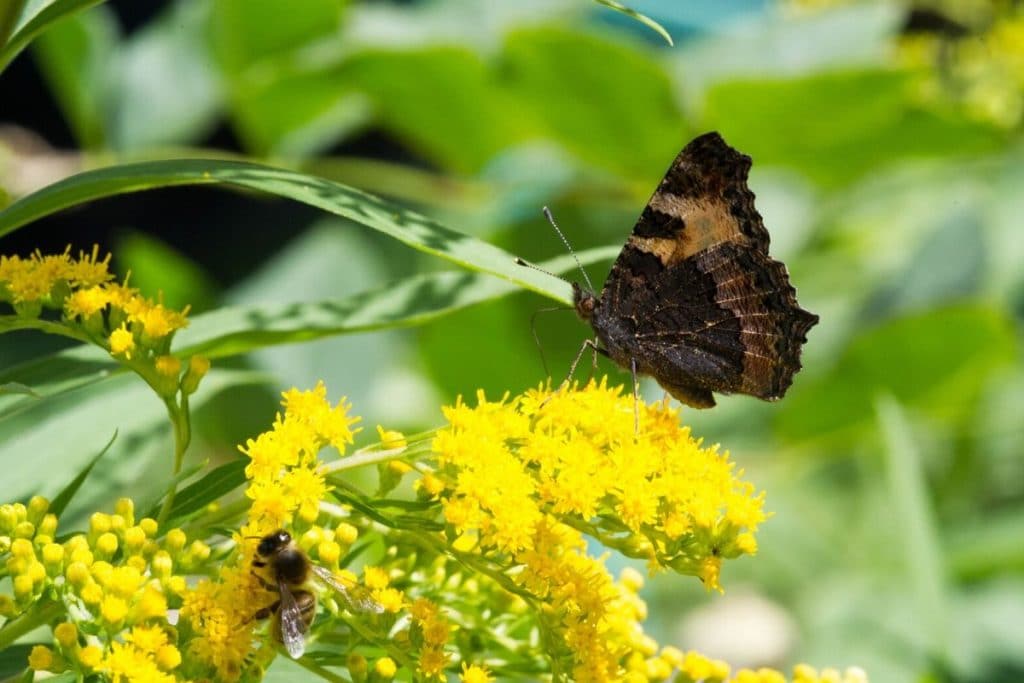When flowers are in bloom, it also means bees and butterflies will be out and closer with flowers, gardens, and wildflowers. You will see them gracefully flying as if they are dancing over the flowers, and that’s the happiest moment of their lives.
In this guide, you will discover the types of flowers that attract these pollinators the most.
- What Are Pollinators?
- Best Flowers To Grow For Pollinators
- 1. Allium
- 2. Aromatic Aster
- 3. Bee Balm
- 4. Blue Wild Indigo
- 5. Buttonbush
- 6. Butterfly Bush
- 7. Catmint
- 8. Clove Pink
- 9. Cornflower
- 10. Daylily
- 11. False Indigo
- 12. Fleabane
- 13. Floss Flower
- 14. Globe Thistle
- 15. Goldenrod
- 16. Helen’s Flower
- 17. Hollyhock
- 18. Joe-Pye Weeds
- 19. Lavender
- 20. Lilac
- 21. Lychnis
- 22. Mallow
- 23. Milkweed
- 24. New York Ironweed
- 25. Ninebark
- 26. Pansy
- 27. Purple Coneflower
- 28. Sea Holly
- 29. Lantana
- 30. Tulip
- Common FAQs
Bees and butterflies are one of the most welcomed additions to any garden or home landscape for apparent reasons. Butterflies come in all varieties of colors, shapes, and sizes.
In contrary to popular belief, bees are not bound to be black and yellow. They come in different colors, which include; white, red, orange, green, blue, and even purple. However, both of them add life to your landscape.
What Are Pollinators?
As you know, pollinators such as butterflies, bees, birds, bats, beetles, moths, flies, wasps, etc… are fabulously necessary for your garden, orchard, and especially for your entire homestead.
Bees and butterflies are probably more important. They like flowers because they feed on their nectar and pollen. They use the nectar as food and an energy source to transport pollen to and from their home.
They need flowers and flowers need them. Because of this, flowers have established a unique way to get their attention, and as humans, we can’t see it. They have different types of eyes. In short, we view the world very differently because of how we process lights and colors.
Planting flowers is a great way to attract pollinators to your garden. Flowering plants are obliged to get pollen from one flower to another, either within a plant for self-pollination or cross-pollination. However, pollen can’t move on its own, and there is a reason why they are so attractive to bees and butterflies.
Best Flowers To Grow For Pollinators
Here are great examples of attractive flowers for bees and butterflies that you probably have or can have in your garden.
1. Allium
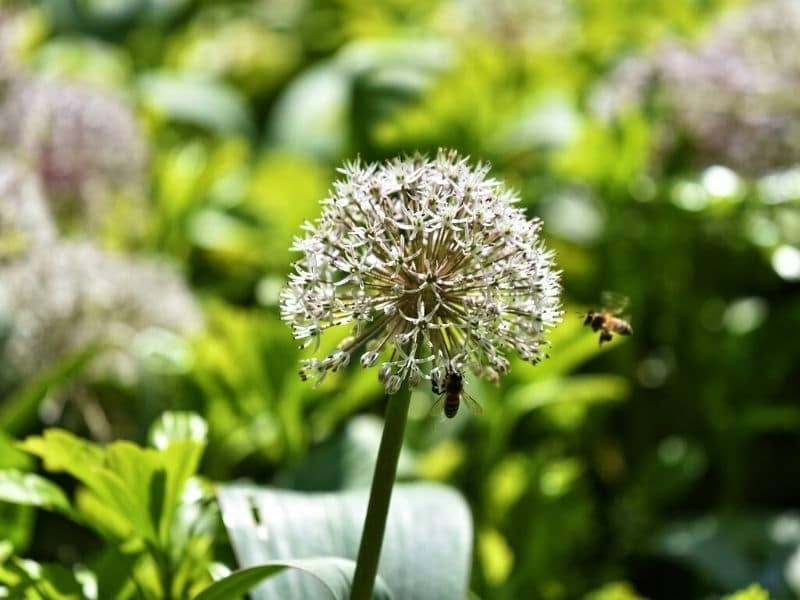
Allium (Allium giganteum) usually grows up to 5 feet high. Some of them are tall, and some of them are just short. They have a powdery aroma and come in different varieties. People name this flower a ‘Giant Onion.’ This flower is an Asian class of onion. Allium giganteums are native plants to central and southwestern Asia, yet it is cultivated in many countries as a flowering garden plant.
2. Aromatic Aster
Aromatic Aster (Symphyotrichum oblongifolium) are daisy-like perennials with a star-like shaped flower head. They are versatile, easy-to-grow ground cover for dry, sunny locations, and an indigenous perennial wildflower that grows from 1–3 feet tall.
The flowers turn reddish-purple as they develop. Contrary to its name, the flowers have no aroma, but the leaves do when squeezed. They bring amusing color to the garden in late summer and autumn when many of your other summer blooms may be fading.
3. Bee Balm
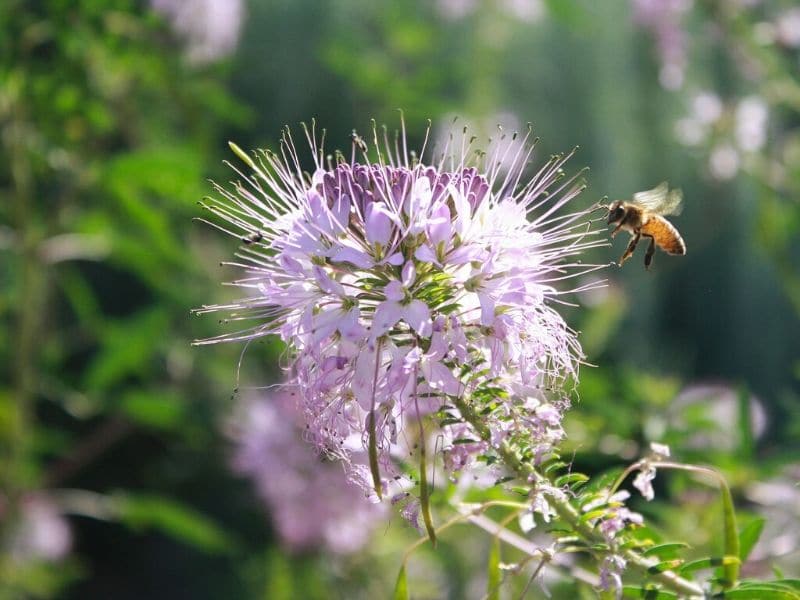
Their unique appearance can help you quickly identify a Bee Balm (Monarda didyma) plant. Basically, they are found in pink, red, and white colors. The plants are common herbaceous perennials.
Herbaceous plants are those that have non-woody stems. A “perennial” plant is a plant that endures the winter, even when its growth above the ground dies.
Butterflies and bees are fascinated by this plant because of its strong fragrance and nectar. The plant grows and spreads swiftly, so they need lots of spots to develop.
4. Blue Wild Indigo
Blue Wild Indigo (Baptisia australis) is a group of large, long-lived perennials. They add a long season of interest from flowers and foliage, and species modify their height and width. Some species grow no more than 1 to 2 feet tall.
Their fragrant blooms entice butterflies and bees to your yard. Flowers are held in exciting straight-up races. In other words, flower spikes with a short stem attaching each flower to the central stalk. Their flower spikes can be 12 to 24 inches tall, composed of typical pea-shaped flowers.
5. Buttonbush
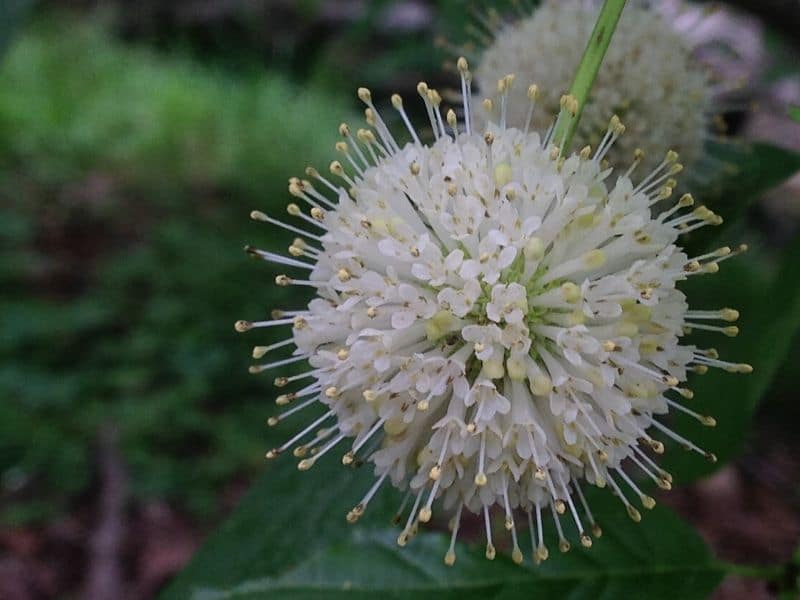
Common Buttonbush (Cephalanthus occidentalis) is a multi-stemmed shrub that grows 6-12 feet or periodically taller, and trunks are often twisted. Their polished and dark-green leaves lack vital fall color. Moreover, these white flowers are long-lasting, and its one-inch globes and bizarre blossoms are white or pale pink. Afterward, rounded masses of nutlets linger over the winter.
When these plants are blooming, they’re sure to captivate honey bees as well as butterflies. When the bees are working on this plant, the apiary usually has a rich scent at night.
6. Butterfly Bush
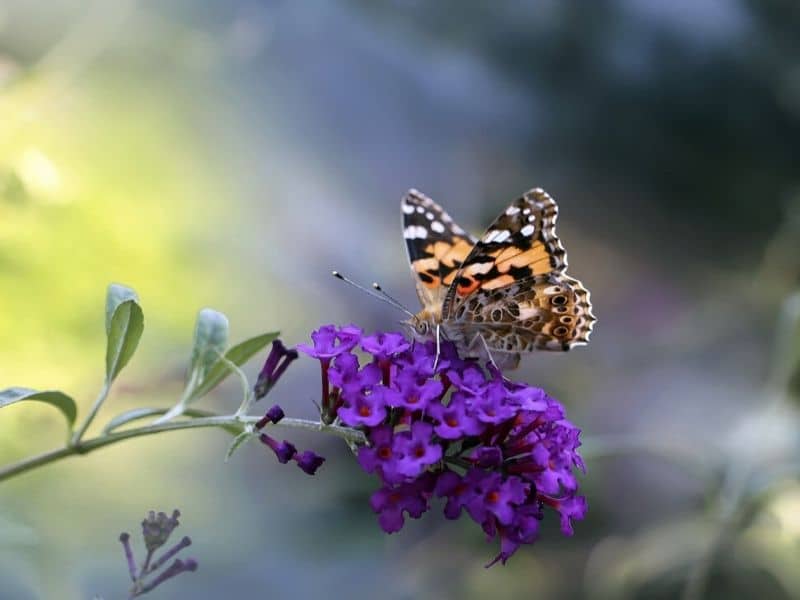
The butterfly bush (Buddleja davidii) is a choice among gardeners. The plant is uncomplicated to grow. In a well-drained ground, they can endure a full scope of climates, from very wet to intensely dry. They have a long growing season, usually during mid spring and summer, reaching into the fall in warmer climates.
7. Catmint
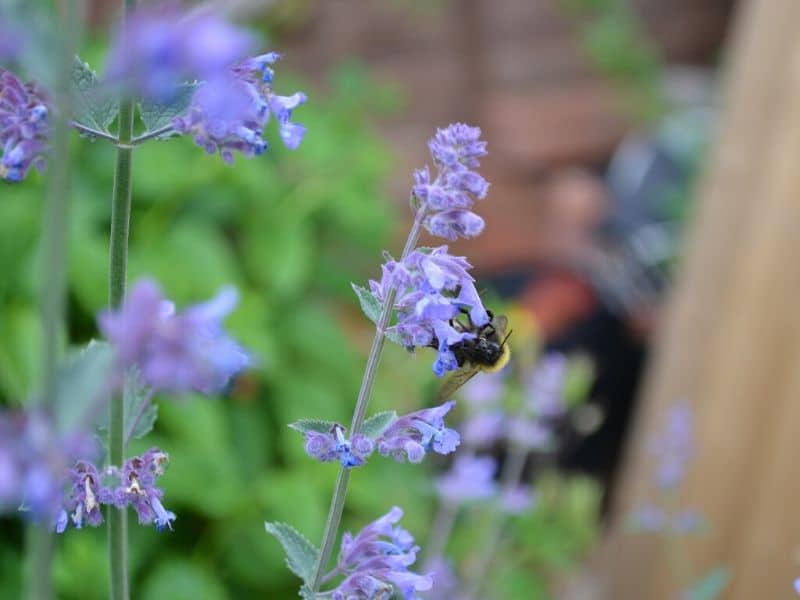
Catmint (faassen nepeta) is a member of the mint family, but please don’t rapidly send away this attractive perennial if you’ve had a concern with invasive mint in the past. This plant is much more natural to grow and a bonus for being well-behaved.
The catmint adds beauty and food for beneficial insects all summer long. They produce long-lasting flower spikes that are highly tempting to honey bees and also butterflies. They are fantastic plants for use in rock gardens, along with pathway points, or as buddy plants in rose gardens.
8. Clove Pink
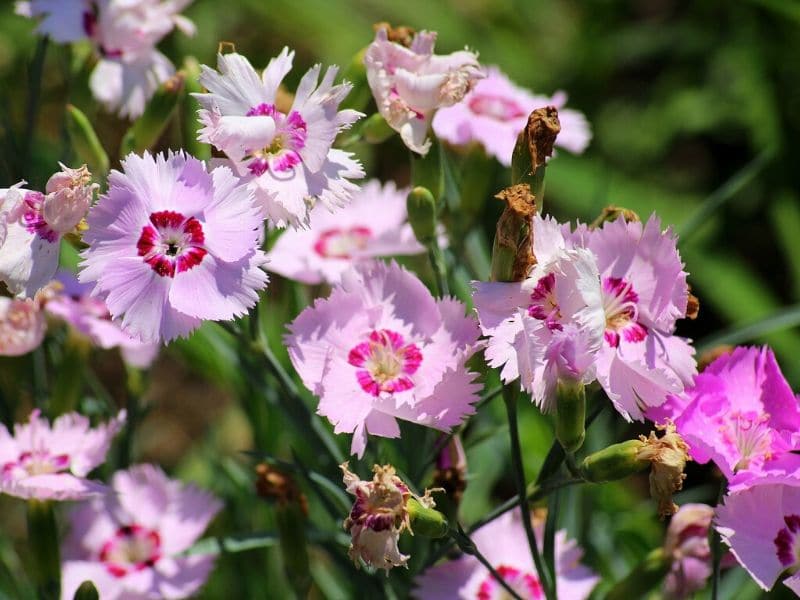
Gardeners with little areas to fill and sunny locations would do well to try growing Clove Pink (Dianthus caryophyllus) flowers. Not only do the plants have an opaque feathery form, but the alluring, scented flowers have a long herbal history – both in medicine and as edible ornament and flavoring.
The plant before blooming has an airy structure and organized arrangement, but once they flowers, they attain a stable condition decorated with tiny fragrant flowers that attract birds such as hummingbirds and insect-eating birds.
Clove Pink is the native ancestor of today’s garden carnation, which has been advanced into cultivars of various colors like yellow, white, and red.
9. Cornflower
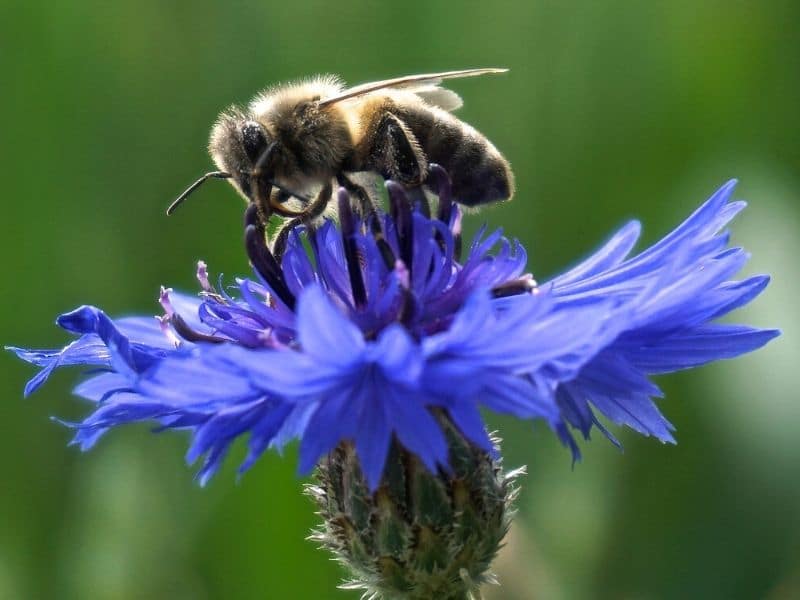
Cornflowers (Centaurea cyanus) are famous in wildflower gardens and would be fitting as borders in garden beds. These old-fashioned flowers are easy to bloom, drought-tolerant, and can thrive in most soil conditions. The flowering span is from June to September. Do not forget to plant in full sun and in well-drained moist soil.
Cornflowers are dependable and long-flowering. These are essential sources of nectar and pollen in most areas, and their flowers are typically blue, pink, yellow, white, or various tones of purple. Bees are specifically enticed to the blue and white-flowered ones. Cornflowers are also known to attract hummingbirds.
10. Daylily

Daylilies (Hemerocallis citrina Baroni) may be the coolest of all blooming perennials. The plants grow swiftly and are long-lived. They bloom in almost several classes of soil, will grow in sun or shade, and are seldom troubled by insect pests or disease.
These flowers are known for their firmness and by their large and colorful flowers. Flowering begins in midsummer and endures into early fall, with new blossoms opening each day.
Daylilies are tempting to many pollinators, including butterflies and bees. Part of that fame is due to the cup-like shape that causes these tiny living creatures to gather up the sweet nectar they need for attracting pollinators and blooming.
11. False Indigo
No other flower can load your garden with dazzling blue flowers like blue False Indigo (Baptisia australis). This beautiful flower is a native American allure. They are part of the pea family, and you will notice the similarity in its plant and flowers, as well as its tenderness for colder weather.
False Indigo has a vertical shrubby form. They give a long period of interest, with intensely-hued flower spikes, incredible seed pods, and growth that is seldom disturbed by pests or disease. They are essential for bumblebees and butterflies that can open or grasp into the pea-like flowers and approach the nectar.
12. Fleabane
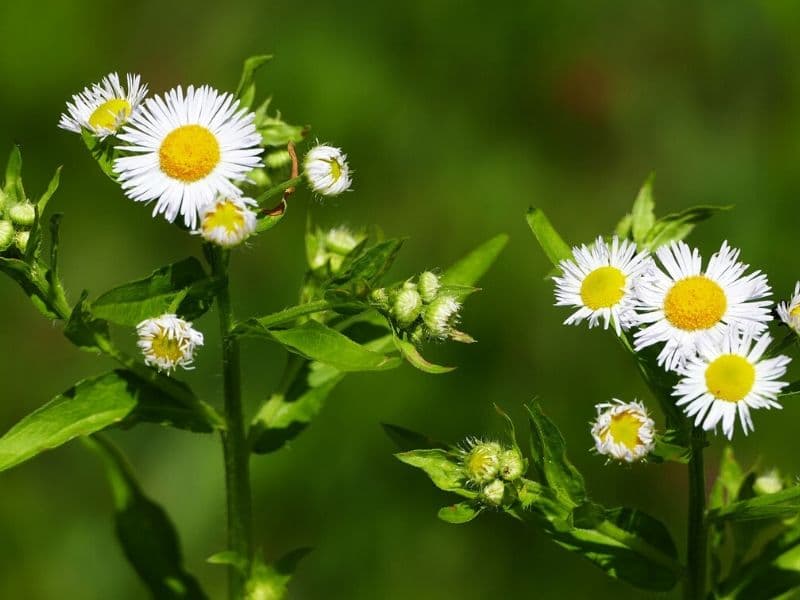
You may have seen this beautiful, daisy-like wildflower in the garden, against buildings and fences, and along roadsides in early spring and early summer. Fleabane (Conyza bonariensis) flower heads sort from white to pinkish to pale purple. The plant is easy to control through trimming.
Their easy-going reproductive movements, along with its attractiveness, make it an optimal weed—also, a massive element for such pollinators like bees and butterflies.
13. Floss Flower
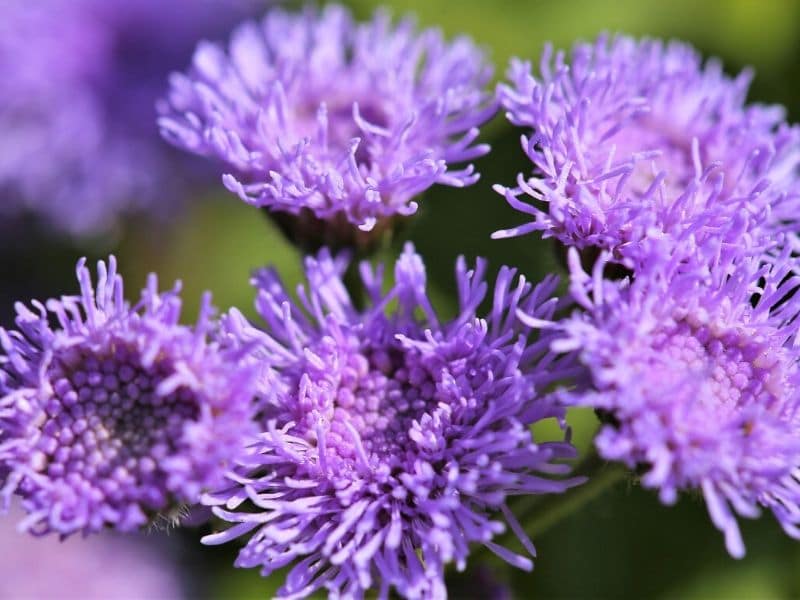
Floss Flower (Ageratum houstonianum) is a yearlong flowering plant native to Mexico. The floss flower plant gives furry flowers in rounded, compact flower heads, adding a fascinating blue flower color to the garden. With limited shade, they can develop from 12 to 39 inches tall.
The floss flower grows from late spring through summer, and all the exceeding characteristics make this species of flowering plants a refreshing choice for outdoor containers. They are excellent nectar origin for butterflies and bees in late autumn. They are one of the last meals that the pollinators can find before extreme cold puts everything to bed for the whole period.
14. Globe Thistle
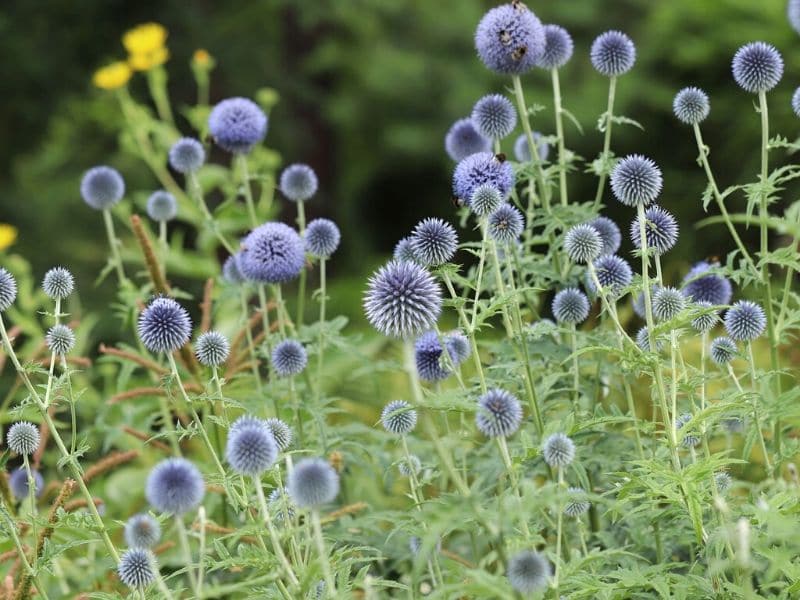
Globe thistle (Echinops ritro) is part of the Aster family. The immense spiky flowers pop up in early summer and last up to 8 weeks. They are gorgeous flowers with deep dark blue petals position in a spiky frame. The leaves are entirely notched – dark green on top and kind of silver underneath and somewhat fuzzy. The plants originate from Asia and Europe.
This mid-summer flower will have bees falling over themselves to work, and it is not uncommon to see numerous types of bees and butterflies working a single flower head in unity. Globe Thistle is also known to produce seeds that can be used to propagate new plants.
15. Goldenrod

Goldenrod (Solidago) is an elegant plant only when they thrive, and their stalk and leaves have a “weedy” look to them. Their flower time changes from midsummer to late summer through fall, depending on the type. But overall speaking, this plant is tall and slim (occasionally growing as high as 10 feet tall) with soft, golden flower spikes.
Goldenrods are champions among many plants when it comes to late-season pollinator support. Honey bees and butterflies often assemble massive imports of goldenrod nectar earlier to winter. Other bees use the pollen to stock late-season nests. These yellow flowers are usually thick and somewhat sharp in aroma and fast to granulate. The average sugar absorption in the nectar of some goldenrod species has been stated at approximately 33%.
16. Helen’s Flower
Many butterflies and bees visit the crowd of bright, one-inch flowers in late summer. Helen’s Flower (Helenium amarum) is a glamorous and beneficial mid-sized native for wet or watery gardens. This flower is the namesake of a royal queen, and when you see how beautiful this flower is, you’ll figure out why.
They flower late-season and second, and unremarkable until they bloom turn them into a boasting beauty. Helen’s Flower task in the garden is to welcome fall with its fun autumn colors of bronze, russet, orange, gold, and yellows, or a blend of them all.
17. Hollyhock

These easy-care plants come from China and the Mediterranean. Hollyhocks (Alcea rosea) give classy blossoms that entice butterflies and bees to the garden. Plant hollyhock seeds during winter to provide small blooms by summer.
Hollyhock varieties are possible in white, pink, red, yellow, purple, chocolate, black, maroon, raspberry, and apricot colors.
18. Joe-Pye Weeds

Joe-Pye Weeds (Eupatorium purpureum) do best in full sun to limited shade. They also admire to be kept relatively moist in moderate to fertile soil. Growing Joe-Pye weed will even endure wet soil conditions but not exceedingly dry sites. Therefore, in the field with hottest days and dry summers, plant these ornamental charms in limited shaded locales.
The flowers come in a range of colors from white to pink, to purple – depending on the variety – and attract butterflies and bees. Although others have never seen honey from Joe-Pye weed, it is stated to be a dark orange-amber color with a fruity essence.
19. Lavender
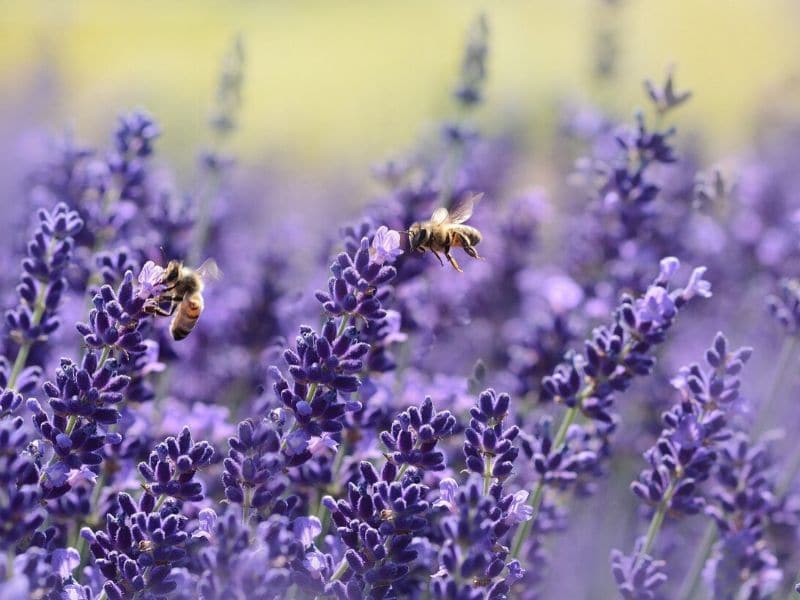
Lavender (Lavandula angustifolia) is common in herb gardens for their scented leaves and charming flowers. They are small evergreen shrubs with gray-green ancient linear leaves. The purple flowers are freely organized on spikes at the tips of long bare stalks.
The aroma of the plant is caused by dazzling oil glands planted in the middle of tiny star-shaped trichomes (plant hairs) that wrap the flowers, leaves, and stems, and the other reason why such pollinating insects as bees and butterflies visit this plant regularly.
20. Lilac
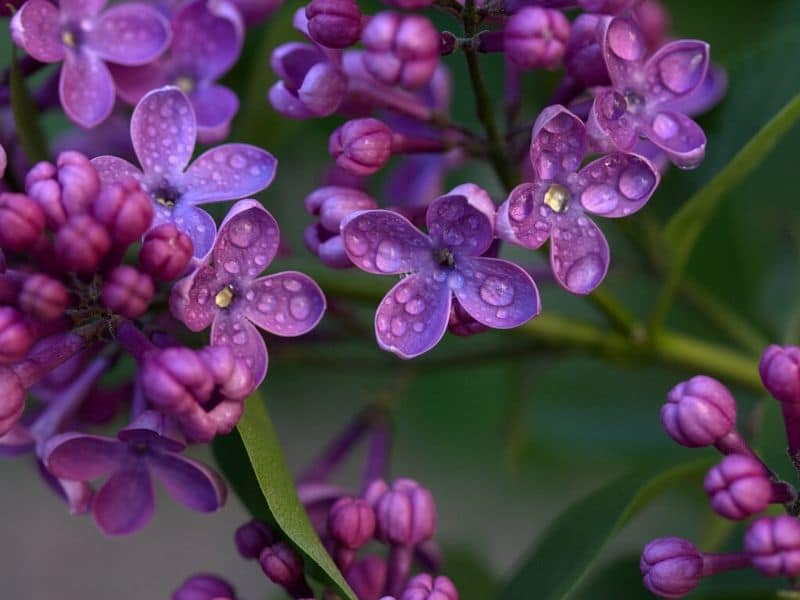
It’s uncomplicated to find Lilacs (Syringa vulgaris) and lilac bushes in North America. They can rise from 5 to 15 feet tall, depending on the type.
The optimal lilac shrub has about ten canes. It gives flowers at eye-level all the better to appreciate that sweet and nostalgic fragrance that also affects bees and butterflies—the scent changes depending on the lilac variety from thrilling and sweet to spicy and extraordinary.
21. Lychnis
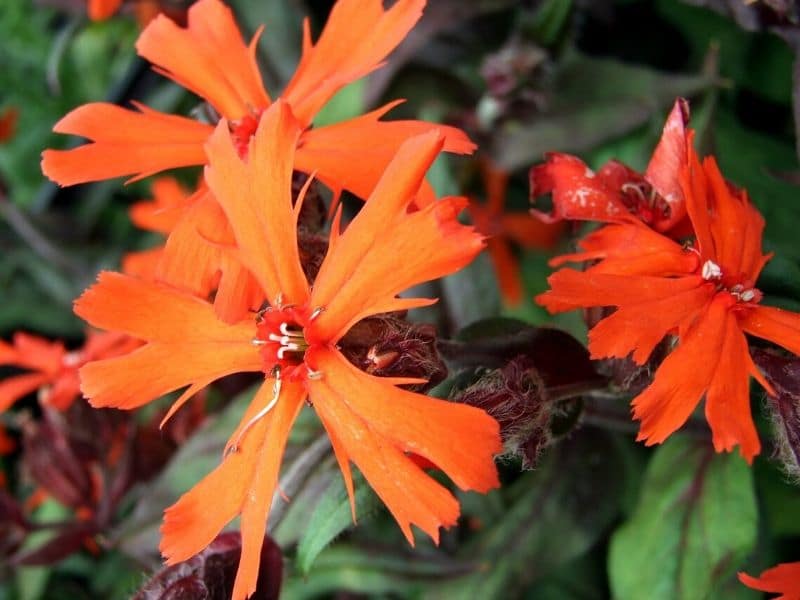
Lychnis (Lychnis coronaria), also well-known as ‘Rose Champion’, is an old-time favorite that boosts sparkling color to the flower garden in the tone of magenta, bright pink and white.
This attractive and long-flowering perennial attracts pollinators such as bees and butterflies with its nectar-pollen-rich flowers. Lychnis is marvelous for a sunny border and supports the bees engaged for the whole summer.
22. Mallow
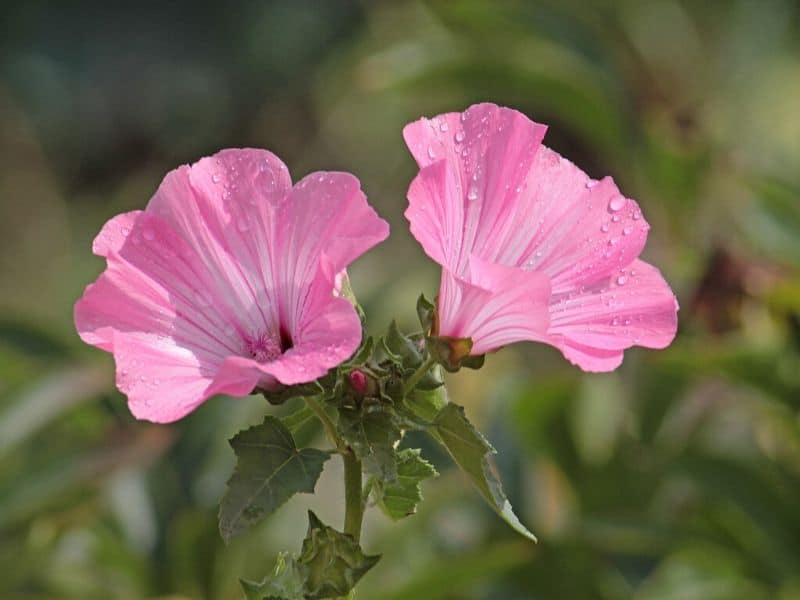
Few “weeds” create a smile on many faces like Mallow (Malva sylvestris) flowers do. Ofttimes treated a nuisance to many gardeners, Mallow Flowers is an exquisite wild rarely treasure.
These flowers are a distinct outstanding element of these unique plants, and the leaves are heart-shaped. They make a splendid addition to mixed flower gardens that bees and butterflies graciously fly above Mallow Flowers.
23. Milkweed

The milkweed flower (Asclepias syriaca) plant may be treated as a weed and are usually isolated from the garden by those unaware of its unique attribute. Indeed, they may be found growing roadsides simultaneously, in ditches, and may need removal from commercial areas. However, the cause for planting milkweed in the garden flies by in summer.
The seducing milkweed flower ranges in color from pink to purple to orange and blooms from June to August. These flowers give a lot of nutrients that help the Monarch caterpillars to change entirely into beautiful butterflies.
24. New York Ironweed
New York ironweed (Vernonia noveboracensis) is a towering, bundle-forming perennial, growing 5-8 ft. in height. They have little rough stems that bear lance-shaped, deep-green leaves.
Its tall, erect stem branches approach the summit, with each branch bearing a bunch of deep blue and purple flower heads together. Its small flower heads develop in large flat-topped, loosely branched, and extreme bunch. Flowers are round and dark reddish-purple.
25. Ninebark
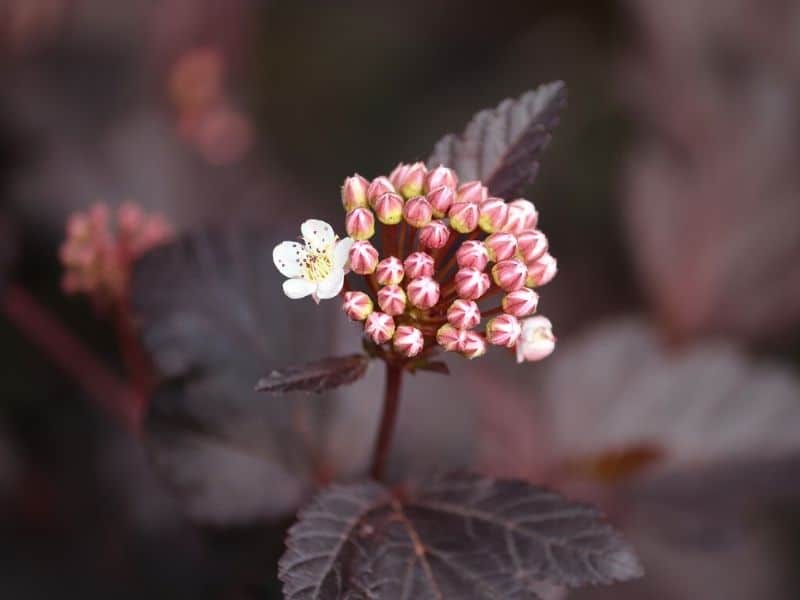
Ninebark (Physocarpus opulifolius) is an adaptable flowering shrub extensively used in landscaping. It gets its name from its bark, which can be peeled off in many (potentially nine) slim layers. Ninebark features dark green or reddish leaves that form an alluring overflowing hill.
They bloom in late spring with a bunch of white or pink flowers, which often attract pollinators like bees and butterflies. Plant Ninebark in an area that gets full sun to limited shade, as it flowers best under full sun. They are usually tolerant of the different temperatures and humidity levels within their favored hardiness areas.
26. Pansy
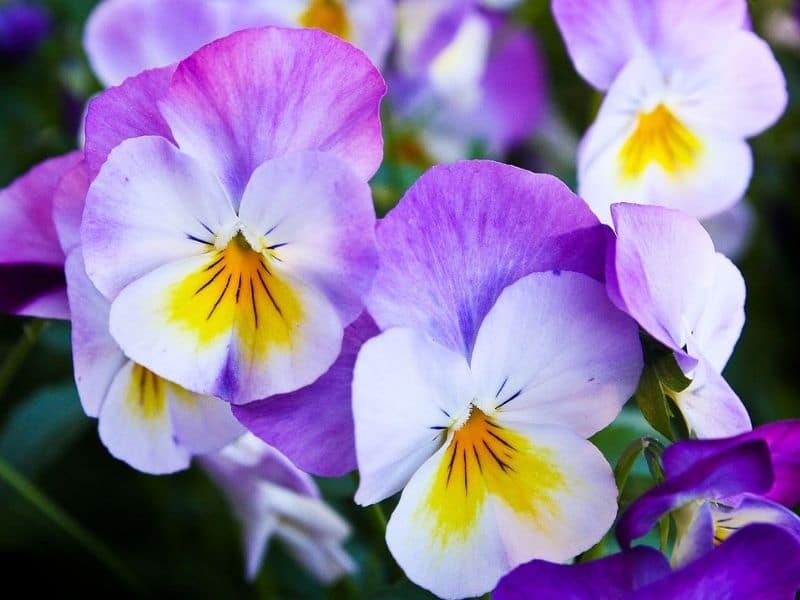
Pansies (Viola) are aromatic, and edible blooms enticing in gardens. The flowers are single with five petals that are spherical. Pansy plant popularity boost possibly due to its comfort of growth.
Pansies seem to radiate more fragrance in the early morning and sundown. The yellow or blue pansy flowers seem to have the strongest fragrant.
27. Purple Coneflower
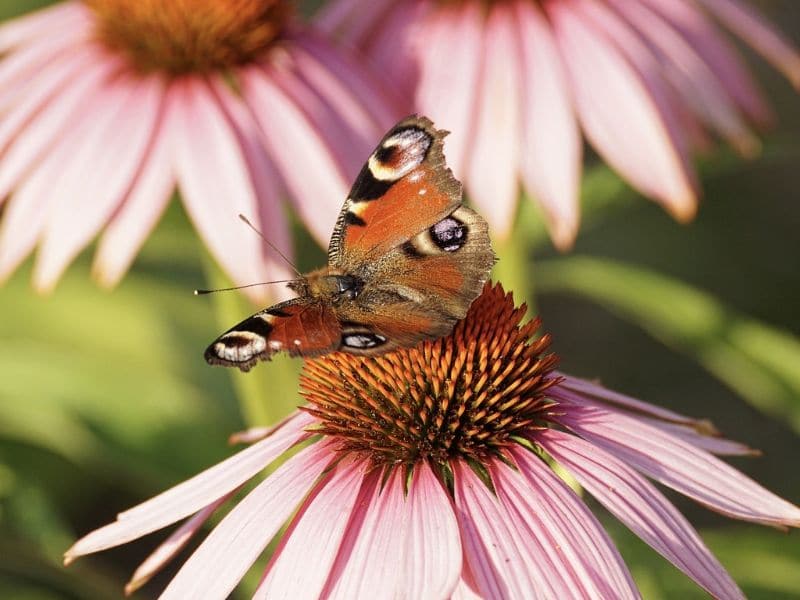
Purple coneflower (Echinacea purpurea) is a firm perennial wildflower that accommodates easily to a kind of growing environment, including the stage of heat and dryness.
This flowering plant has an intensely hued, daisy-like wildflower that develops on top of stiff, 2- to 4-feet stems and medium-green, lance-shaped leaves. The narrow, floppy petals, in shades roaming from lavender, pink and purple, scatter from coppery brown seed heads.
28. Sea Holly
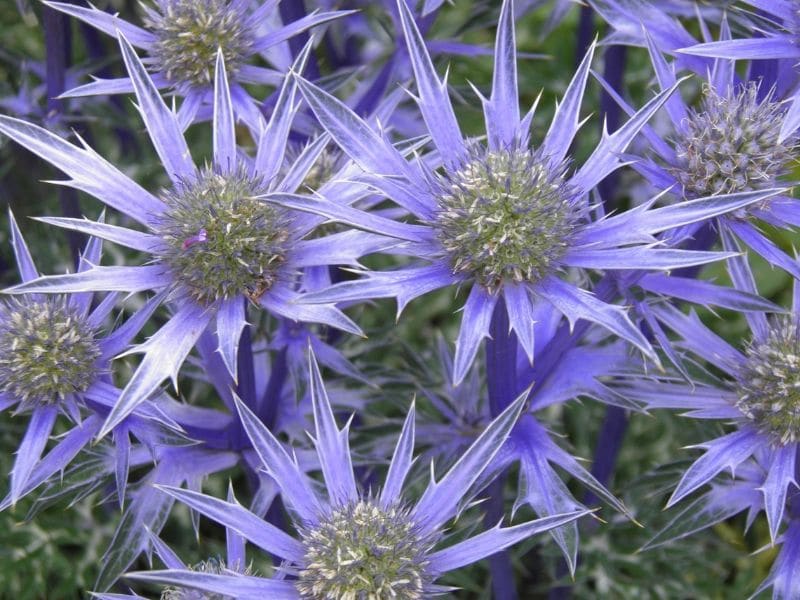
Sea Holly flowers (Eryngium) can give exclusive passion with their spiny-toothed leaves and a bunch of teasel-like blossoms. They also offer flexibility with their wide field of the growing environment and assorted uses in the garden.
Their green or silvery-blue stems give aspect to green or blue cones encircled by spiky silver, white, green, blue, or violet leaf, which bloom from summer through fall. Although they have no pleasant odor, Sea Holly attracts butterflies and bees. Their exotic beauty is fascinating.
29. Lantana

Lantana flowers are highly attractive to butterflies and hummingbirds, and other pollinators, making them a valuable addition to gardens. Their vibrant, clustered blooms, available in a variety of colors, including shades of pink, orange, and yellow, serve as a rich nectar source for bees, butterflies, and hummingbirds.
Lantanas bloom prolifically throughout the warm months, providing sustained nourishment for pollinators and enhancing the biodiversity of the garden. Additionally, their hardiness and adaptability make them a resilient and low-maintenance choice for those looking to support pollinators in their outdoor spaces.
30. Tulip

Tulips (Tulipa) are some of the most popular spring flowers of all time, and the third most famous flowers worldwide next only to the Rose and Chrysanthemum.
Tulips come in an incredible variety of height, colors, and flower forms. Some tulips are even fragrant, which can invite the bees and butterflies to come over.
Tulip flowers are well-known for being almost entirely well-proportioned. Most tulips sprout a single flower bud, but a few types have up to four on a single stem. Tulips are also said to cue the arrival of spring.
Common FAQs
What are the best early flowers for pollinators?
The best early flowers for pollinators include crocuses, snowdrops, and winter aconites, which provide nectar and pollen sources when other plants are scarce.
What is the most common flower that bees pollinate?
Bees commonly pollinate a variety of flowers, but some of the most common ones include sunflowers, lavender, and daisies, which are highly attractive to bees due to their abundant nectar and pollen.
*Featured Photo by ekina1/depositphotos

